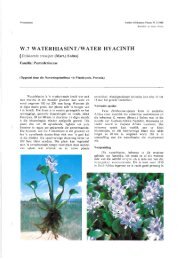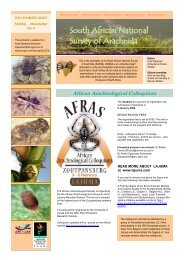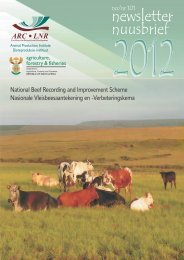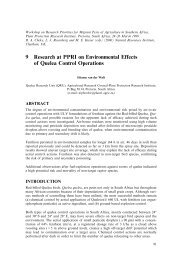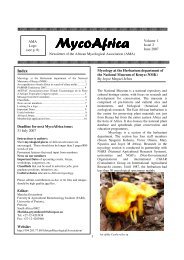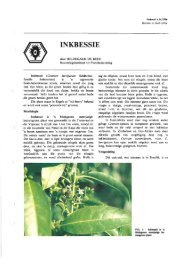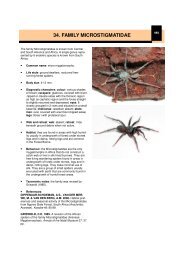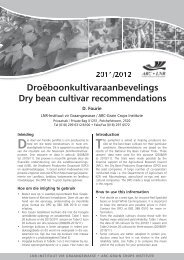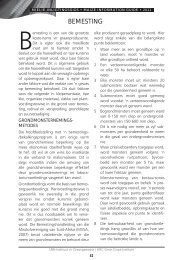The Acacia Gall Rust Fungus, Uromycladium tepperianum
The Acacia Gall Rust Fungus, Uromycladium tepperianum
The Acacia Gall Rust Fungus, Uromycladium tepperianum
Create successful ePaper yourself
Turn your PDF publications into a flip-book with our unique Google optimized e-Paper software.
<strong>The</strong> <strong>Acacia</strong> <strong>Gall</strong> <strong>Rust</strong> <strong>Fungus</strong>, <strong>Uromycladium</strong> <strong>tepperianum</strong><br />
A fungal pathogen of Port Jackson (<strong>Acacia</strong> saligna) in South Africa<br />
Alan Wood<br />
Plant Protection Research Institute, Private Bag X5017, Stellenbosch, 7599<br />
Description<br />
<strong>Uromycladium</strong> <strong>tepperianum</strong> (Sacc.) MacAlpine is a rust fungus<br />
originating from Australia where it naturally attacks Port Jackson. It<br />
causes the production of large irregularly sized galls on the leaves<br />
and stems, as well as witches’ brooms. <strong>The</strong> single-celled, brown<br />
teliospores are produced on pedicels, 3 teliospores to a pedicel.<br />
<strong>The</strong>se are approximately 0.02 mm in diameter and ridged. <strong>The</strong><br />
teliospores are produced in mass on the surface of the galls,<br />
appearing as a brown powder that is easily brushed off.<br />
Life Cycle<br />
<strong>The</strong> teliospores are spread by wind. After germinating they infect the<br />
tree by directly penetrating into epidermal cells of young phyllodes<br />
(“leaves”), stems and flower buds. From there they colonize the<br />
surrounding plant tissue and induce the formation of galls or witches’<br />
brooms. Teliospores are produced from May to about August.<br />
Germination occurs when there is freely available water on the plant surface (overnight dew or<br />
light rain), and the temperature is 10–20°C. <strong>The</strong>se conditions are<br />
prevalent in spring in the Western Cape, when the plants are most<br />
actively growing and flowering.<br />
Disease Symptoms<br />
Infected Port Jackson trees are covered in conspicuous, knobly, redbrown<br />
galls, or sometimes witches’ brooms, on branches, phyllodes<br />
or flowers. New galls often develop in February to March, the fungus<br />
having infected the plant at the end of the previous rainy season.<br />
New galls can be produced any time from then until late spring (while<br />
the tree is actively growing). <strong>The</strong> gall rust fungus uses the plants<br />
nutrients, resulting in a reduction of growth and seed production.<br />
Heavy gall loads lead to the plant not being able to cope with environmental stresses, especially<br />
drought over the dry months, and the plant then dies. <strong>The</strong> acacia gall rust fungus, like all rust<br />
fungi, can only live inside a living host plant. Once the plant dies the<br />
fungus also dies.<br />
Method of Use<br />
<strong>Uromycladium</strong> <strong>tepperianum</strong> spreads rapidly by wind blown<br />
teliospores, and is now distributed throughout the range of Port<br />
Jackson. <strong>The</strong>re is therefore no need to artificially redistribute the gall<br />
rust fungus. Intense fires or clearing operations do result in the local<br />
extinction of the gall rust fungus, though it will naturally reinvade the<br />
area within a few years. To allow the maximum benefit of the gall<br />
rust, frequent fires should be avoided, as well as improperly<br />
executed clearing operations. <strong>The</strong>se both benefit the plant and only<br />
result in an increase in the density of the weed. <strong>The</strong>re is a saving on<br />
the cost of properly done clearing operations, with chemical<br />
treatment of the cut stumps, if done once the density of the weed is<br />
<strong>Gall</strong> of <strong>Uromycladium</strong><br />
<strong>tepperianum</strong><br />
Three teliospores of<br />
the gall rust fungus<br />
that have developed<br />
on a pedicel. Scale<br />
bar = 0.1 mm.<br />
A teliospore of the<br />
<strong>Acacia</strong> gall rust<br />
fungus
allowed to decline over time. It must however be borne in mind that follow up treatments will have<br />
to be done for many years because of the high numbers of long-lived seed already produced and<br />
which is stored in the soil. But again there is a saving due to the reduced number of seedlings<br />
that germinate.<br />
Impact on Port Jackson<br />
Before the introduction of U. <strong>tepperianum</strong>, Port Jackson was rapidly invading new areas and<br />
forming large, dense infestations covering large areas of the lowlands of the Western and Eastern<br />
Cape Provinces. However, since its release, the density of trees in invaded areas has declined<br />
dramatically (except immediately after fires and poorly executed clearing operations). Also the<br />
spread of the weed has almost halted. This allows the indigenous vegetation to continue living in<br />
the area, whereas previously they were crowded out by the dense infestations. It is expected that<br />
with time invaded areas will become open woodland with indigenous plants, and grasses,<br />
growing between the scattered Port Jackson trees.<br />
High mortality rates of plants in dense stands associated with high levels of galls




